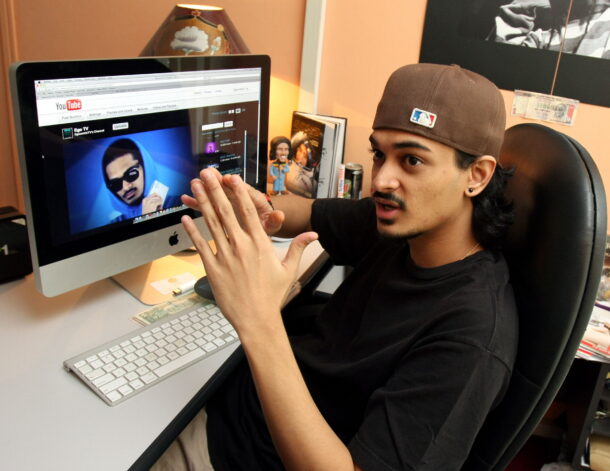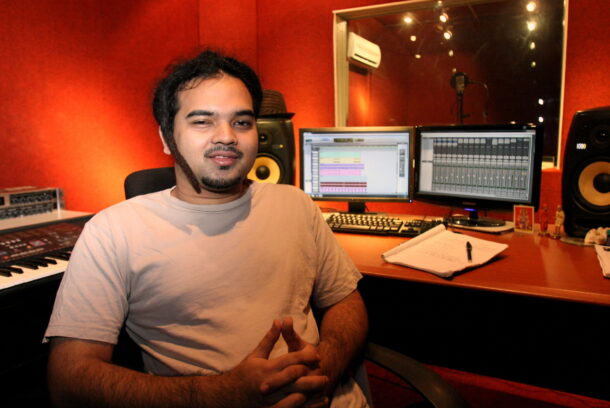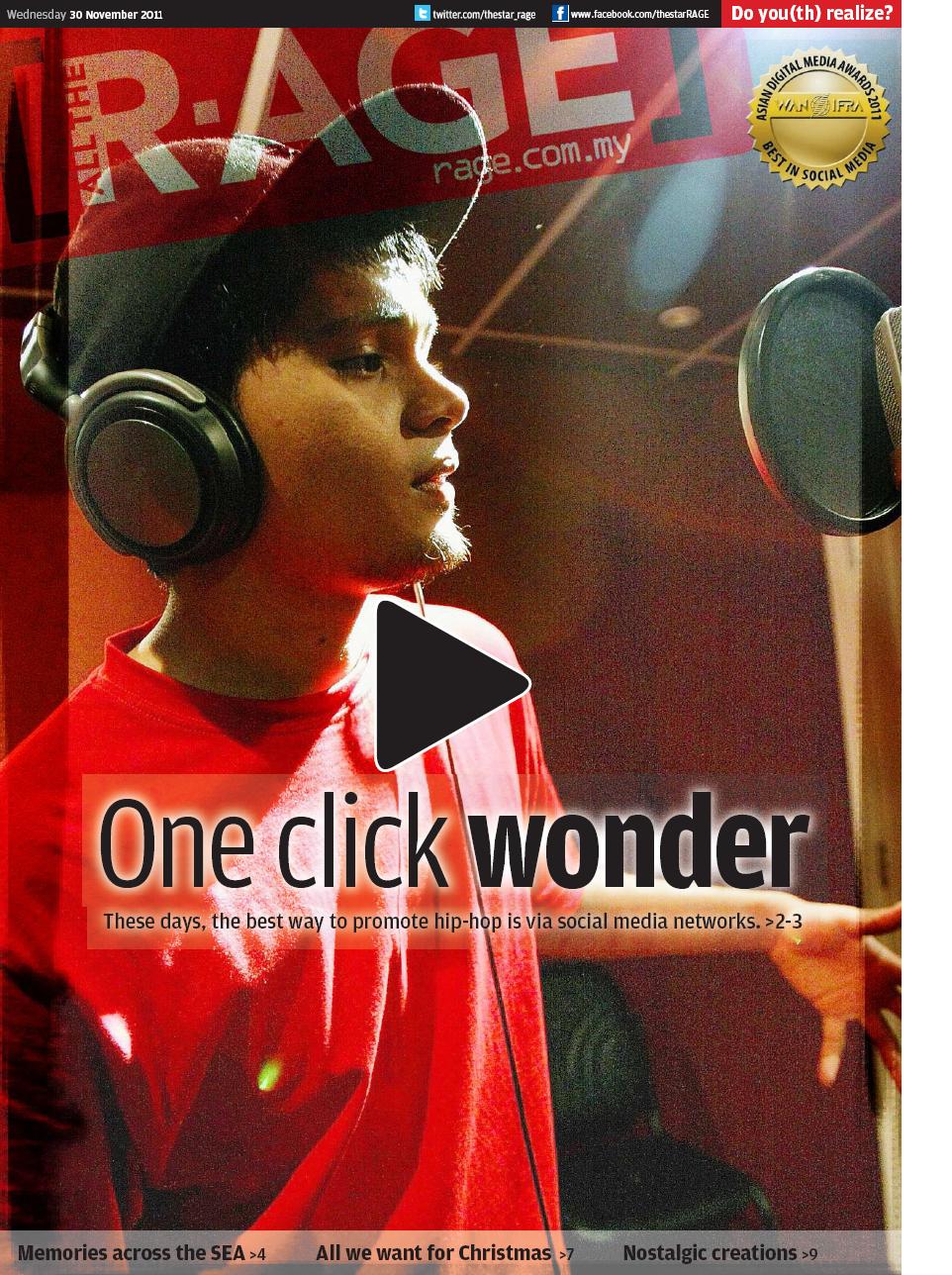By IAN YEE
alltherage@thestar.com.my
Rapper Edmund Anand, 24, aka Ego, recently got a few of his friends from the local hip-hop scene together to record a track and shoot a video.
Everything was done in his studio, a small office space on the first floor of a nondescript row of shop lots in Puchong, Selangor. They recorded the tracks, shot the video and did post-production all on their own, independent style. Ego even made the green screen for the video’s background graphics himself, sewing lengths of green fabric together, and set up his own “studio lighting” by using fluorescent lights removed from his office ceiling.
Ego then posted the finished article, a track and music video called Run This, on his label’s YouTube channel, EgocentricTV.
The video immediately started clocking close to a thousand hits per day. Within eight days, it hit an impressive 10,000 views.
Now that might not seem like much compared to all the international “YouTube sensations” flooding the market right now, but for a Malaysian artiste in a genre like hip-hop that’s still pretty much in its infancy here, that’s a whole lot of hits.

Rapper and Egoistic Records CEO Edmund Anand showing the music video for Run This, a project featuring seven top local rappers (including himself) which Edmund produced independently. The video has gone viral, getting more than 10,000 hits in just over a week.
“I was checking the statistics and there were about 900 people watching a day. I was like, ‘where are all these people coming from?’
“But people are on their PCs all the time now – doesn’t matter if they’re at work or at home. I mean, I’m on Twitter right now on my phone,” said Ego, waving his smartphone.
The stats also showed that most of the hits for Run This had come from people clicking on links that had been shared on Facebook.
With airtime on mainstream radio and TV getting harder and harder to come by, local hip-hop artistes are starting to turn to social media to get their music heard, and it’s been going pretty well for them.
Fans of the local hip-hop scene now stay up to date by logging on to YouTube or Facebook to watch the latest performances, music videos and freestyle battles.
Using tools like YouTube and MySpace to help spread music isn’t anything new, but in Malaysia in particular, hip-hop artistes are starting to realise just how well hip-hop and social media go together.
Rapper Ashtin Sanjiv, 20, aka M.I.O, recorded a video of himself freestyling using a basic digital camera.

Rapper Ashtin Sanjiv, a.k.a. M.I.O., once posted a simple video of himself freestyling and it got over a thousand views. Now, he’s planning to release his upcoming album with hip-hop duo Random Thoughts using YouTube.
Pleased with the result, he posted it on YouTube and just like that his video got over a thousand hits.
A spontaneous track like that would probably have never stood a chance of making it to mainstream radio, but on social media, stuff that’s done on the fly fits in just right.
Most of the other videos on EgocentricTV have over a thousand hits as well, and with the success of Run This, their future videos would probably average even higher.
But it’s not just the potential exposure with social media that M.I.O is excited about. It’s the creative possibilities.
“I’ve been rapping for as long as I can remember,” he said. “But with social media now, the game’s really changing – not just for hip-hop but music in general.
“It’s been good for hip-hop in particular because there are fewer boundaries on social media. You can be more creative, and you can say whatever you want.”
Even the publicity for his new album will be done using a relatively new idea.
The album, by M.I.O and fellow rapper Umair Al-Zubair Amirhamzah, 24 (aka Al-Z), who together form hip-hop duo Random Thoughts, will be promoted using the annotations function in YouTube, which allows users to insert links onto a video.

Rapper Al-Z took a five-year break from the hip-hop scene, and he was surprised to see how the game had changed with the emergence of social media.
“We’ll be uploading previews of each track on a single YouTube video, and you’ll be able to click on the annotations at the beginning of the video to take you straight to the track you want to hear,” explained M.I.O. “People now want to find everything they want in one page. They don’t want to have to click around, so this solves that problem.”
Al-Z had been out of the hip-hop game for five years before making his comeback with Random Thoughts, and he was surprised at how quickly things had grown with social media during his absence.
“When I got back, everybody was promoting online,” he said. “I was on Blast Off (a reality TV talent competition) with another hip-hop group before all this – that was one phase in the music industry, with all the reality competitions. But now it’s the Internet, and social media.”
Even Joe Flizzow’s well-established Kartel Records now pushes their music through social media, and one of their most well-know names, Altimet, says it only makes sense for hip-hop to move in that direction.
“Hip-hop has always been about social networking, even before social media. It started out underground, relied a lot on word-of-mouth and doing things like handing out vinyls and collaborating with each other.
“So doing all this (social media networking) is almost like second nature to hip-hop,” said Altimet.
And with social media, Altimet adds, it can be about so much more than just trying to create the next viral hit. If you learn how to “capitalise” on certain trends and situations, you can raise your visibility as an artiste overnight.
“It’s like with Malaysian Boy (the Malaysian version of Kanye West and Estelle’s American Boy). There was a rumour that Kanye was going to sue us, so we capitalised on that. Just from that one incident, I got an extra 2,000 followers on Twitter.
“Everyone thought I must have been scared because they thought I was going to get sued, but it was actually a really good week for me,” he said.
Staying connected
In recent times, hip-hop has become associated with the whole bling culture, where everything’s flashy and big and expensive.
But according to rapper Kraft, who co-owns independent label A-Hustle-Lah Records, hip-hop actually came from a very different place.
“Hip-hop is about everyday life,” said Kraft, one of the rappers featured in Run This. “The origins of hip-hop are not manufactured – it comes from poverty and pain. So hip-hop is very cultural. It’s about society. And what’s the best way to keep in touch (with society) now? Social media.”
Kraft says he’s “been on both sides” – on mainstream media where some of his tracks have gotten airtime, and on social media – so he’s in a good position to comment.
His breakthrough single Diamonds was actually an accidental social media success. He posted the song online to get some feedback, but then radio stations picked up on it and before he knew it, it became a hit.
For Kraft, being tuned in to what’s going on in society is essential in hip-hop, and social media helps artistes maintain that connection.
“The essence of music is, do you touch people or not?” he said. “Sometimes people think we’re not doing anything because they don’t hear us on the radio. But on social media, we’re always connected.”
But Kraft is also quick to emphasise that there are pros and cons with taking hip-hop to social media.
For one, he says social media is starting to get the hobbyists mistaking themselves for professionals. “I play football, but that doesn’t make me a footballer,” he said.
Also, he says some rappers are now so focused on building social media followings that performing live takes a back seat.
But even then he admits that these days, it can actually be easier to connect with your fans on social media compared to live performances.
“Even when I’m performing, I’m not necessarily reaching my demographic. I’ve had old aunties at my show bobbing their heads along. But in social media, you are reaching your direct market.
“If you’re a jazz artiste, your crowd is probably the people buying Mercedes and smoking cigars. That’s who you play to. With hip-hop, the crowd is on social media,” he said.
Another reason why social media has worked so well for Malaysian hip-hop, according to M.I.O, is because of how tight the local scene is.
Social media is helping to keep this relatively small community together, allowing artistes and fans alike to stay in touch and in the know about all that’s been going on – be it a new track release, an up-coming event or a spontaneous rap battle that was captured by someone’s cellphone camera.
“In Malaysia, we can have a rap battle, diss each other’s mothers, and then go for mamak after that.
“We’re all friends – that’s why it works on social media. We’re a community,” said M.I.O.
Some of the rappers on Run This were even from “rival” record labels, but Ego decided to do the video together anyway.
He said: “Hip-hop is all about the ego trip, the rivalry, trying to be bigger than each other… But at the end of the day, we’re actually all friends.
Going viral
According to Ego, the most important thing to remember if you’re an artiste looking to utilise social media is to find a concept that can potentially go viral.
The whole point, he says, is to create something that people would want to share, whether it’s on their Facebook statuses or their Twitter timelines.
For Malaysian hip-hop, the best place to start doing that is by making a music video.
“People won’t listen to your stuff online if you don’t have a video now,” said Ego.
Ego’s record label Egoistic Records, which he started with his brother, produces videos for local artistes. He says he’s often approached by people who either want to make “flashy videos with lots of girls”, or simple videos with no concept.
“Now a lot of artistes just make music videos for the sake of it. But with social media, the music video is the pinnacle of your promotion strategy. If you’re song is good, but your video is bad, there’s no way it’ll work,” he said.


Leave a reply